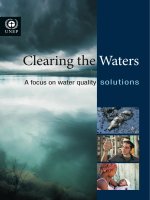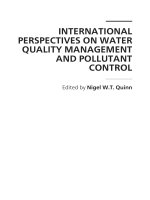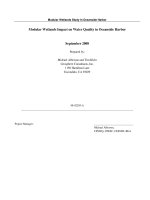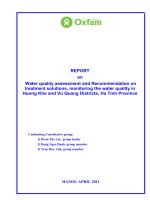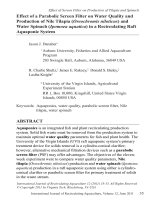Impact of cropping pattern of catchment area on water quality characteristics of riverine ecosystem
Bạn đang xem bản rút gọn của tài liệu. Xem và tải ngay bản đầy đủ của tài liệu tại đây (308.27 KB, 10 trang )
Int.J.Curr.Microbiol.App.Sci (2019) 8(10): 420-429
International Journal of Current Microbiology and Applied Sciences
ISSN: 2319-7706 Volume 8 Number 10 (2019)
Journal homepage:
Original Research Article
/>
Impact of Cropping Pattern of Catchment Area on Water Quality
Characteristics of Riverine Ecosystem
Kusumlata Goswami*, Mahima Tamta, Sumit Kumar and R. N. Ram
Department of Fisheries Resource Management, College of Fisheries,
GBPUA&T, Pantnagar, Uttarakhand, India
*Corresponding author
ABSTRACT
Keywords
Cropping pattern,
Hydrologic system,
Riverine ecosystem,
Water quality
Article Info
Accepted:
04 September 2019
Available Online:
10 October 2019
Land use cropping pattern are altering the hydrologic system and have
potentially large impacts on water resources. The present study aims at
analyzing the impact of various cropping patterns on water quality
parameters of rivers located at Pantnagar, for a duration of three months
from August, 2017 to October, 2017. Three sites Barour (S1), Beni (S2) and
Chakpheri (S3) were selected which exhibits different cropping pattern in
their catchment area i. e. Paddy (Oryza sativa), Dhaincha (Sesbania
bispinosa) and Maize (Zea mays) respectively. Study concludes that
variation in cropping pattern exhibits changes in the water quality
parameters of their respective riverine ecosystem. So, to manage our water
quality parameters we should perform integrated management along with
agriculture sector.
Introduction
Agriculture is the mainstay of many
developing
economies,
contributing
significantly to GDP, food security, direct
employment, export earnings and raw
materials for other sectors (Kutywawo et al.,
2012). With the world’s population continuing
to rise, greater demands are being placed on
our natural resources. The growing demand of
population has resulted in an expansion of
agriculture. There is a large probability that
nutrients and sediment will be delivered to
nearby surface waters from both urban and
agricultural land. Krantz and Kifferstein
(2005) have argued the importance of
understanding water quality problems
associated with land use effects, in order that
we can be instrumental in helping solve these
problems. This reinforces the notion of how
critical it is to understand the effects of landbased developments on our rivers and lakes, in
order to consider appropriate and sustainable
management of these activities.
420
Int.J.Curr.Microbiol.App.Sci (2019) 8(10): 420-429
Land use changes have potentially large
impacts on water resources (Stonestrom et al.,
2009). The relationship between land use and
water quality is helpful for identifying primary
threats to water quality, and the relationships
are meaningful for effective water quality
management because they can be used to
target critical land use areas and to institute
relevant measures to minimize pollutant
loadings (Abler et al., 2002). Agricultural
activity results in ground and surface water
pollution from nitrogen and phosphorus
compounds, which results from the excessive
use of fertilizers containing these ingredients
(Wolska et al., 2001). Water pollution occurs
because human activities such as agriculture,
forest harvest, and urbanization have altered
the structure of the rural landscape and
increased the quantity of substances like
sediments, nitrogen, chlorine, etc. loaded to
the river system (Anbumozhi et al., 2005).
The rapid expansion of agriculture over the
past few centuries led to conversion of natural
or native vegetation to cultivated agricultural
systems. Such changes to land use and
agricultural practices have significantly
increased leaching of chemicals to surface and
ground waters (Carpenter et al., 1998).
Several studies also reported a strong
relationship between cropping pattern changes
and nutrient level enhancements in watersheds
(Liu et al., 2000).
Thus, water quality in agro-ecosystems has
become an important environmental concern,
which has resulted in an expansive body of
literature investigating the relationships
between agricultural land use/land cover and
water quality. The present study was carried
out to evaluate the impact of cropping pattern
of catchment area on water quality
characteristics of riverine ecosystem in three
riverine ecosystems located at Pantnagar of
Uttarakhand, India.
Materials and Methods
Experimental Site
The present study was carried out in three
riverine ecosystems i.e., Barour (S1), Beni (S2)
and Chakpheri (S3) located in Pantnagar
region, Udham Singh Nagar district of state
Uttarakhand, India. Sampling of water was
done from these three rivers located at
Pantnagar, which were approximately 1-2 kms
apart from each other. These rivers exhibit
different cropping pattern in their catchment
area as presented in Table 1.
Duration of Experiment
Experiment was performed for the duration of
three months from August, 2017 to October,
2017. Weekly sampling of water and soil
quality parameters was performed during the
mentioned post monsoon period and observed
for further analysis.
Parameters observed
Different water and soil quality parameters
were observed to estimate the impact of
cropping pattern of catchment area on
physico-chemical characteristics of water
quality.
Soil analysis
Assessment of soil quality of catchment area
was done by estimating parameters like soil
pH, organic carbon, nitrate nitrogen and
phosphate phosphorous. Soil samples were
collected, air dried and sieved for analysis of
various parameters.
Water quality parameters
Sampling for analysis of water parameters was
performed during desired period. Water
samples were taken in sampling bottles and
421
Int.J.Curr.Microbiol.App.Sci (2019) 8(10): 420-429
then analyzed by following standardized
methods of APHA, 2012. Physical parameters
including water temperature and Total
Dissolved Solids (TDS) and chemical
parameters including water pH, dissolved
oxygen (DO), free carbon dioxide (CO2) and
total alkalinity were estimated from the water
samples.
Results and Discussion
Water Quality Parameters
Temperature
It plays very important role in functioning of
chemical and biological activities of
organisms in the aquatic media (Bera et al.,
2014). Riperian
zone reduce water
temperature by shadow effect, decrease
sediment input, filter fertilizer and chemical
substances and thus increase water quality
(Gyawali et al., 2013; Mello et. al., 2017). It
ranges from 25.2 ºC in October to 30.8 ºC in
September. Due to monsoon season in August
temperature was moderate. Maximum
temperature was recorded in September but as
winter approaches it starts decreasing from
October. Out of these three rivers highest
temperature was recorded in Beni river due to
its less depth and blockage of river flow by
artificial impoundment, whereas minimum
temperature was observed in Chakpheri river
due to its turbulent water flow conditions.
Similar trend of decrease in temperature as
winter approaches was observed in the water
quality among different ghats of river Ganga
at Kanpur, India (Khatoon et al., 2013) (Fig.
1).
pH
It is the measure of the acidity or alkalinity of
a water body (Jadhav et al., 2013). It shows
inverse relation with carbon dioxide content
because CO2 increases the acidity of water
body by formation of carbonic acid, therefore
with increase in CO2 content pH of waterbody
decreases. It also shows positive correlation
with alkalinity of water body. Average pH
value of all the three rivers is approximately
same but its value increases as winter
approaches due to increase in DO and
decrease in CO2 content. Santhosh and Singh
(2007) reported that suitable pH range is 6.7 to
9.5 for fish culture whereas above or below
this level of pH is stressful to the fishes. The
present value of pH is lies between the
reported pH range which depicts that water
condition is grossly suitable for fish and
fisheries (Fig. 2 and Table 2).
Total Dissolved Solids (TDS)
Its value ranges from 245-319 mg/l. Similar
findings have been reported by Thirupathaiah
et al., 2012. TDS of August is high then
September because of high influx of sediments
in monsoon season and TDS value shoots up
invariably in all the three rivers in October
which may be due to reduction in growth of
primary producers (phytoplanktons), which
utilizes the dissolved solids of water and
hence large amount of dissolved solids remain
in waterbody. Out of these three rivers
maximum dissolved solids are present in Beni
river (Fig. 3).
Dissolved Oxygen (DO)
Dissolved oxygen content is indispensable for
many aquatic organisms and it also affects the
solubility and availability of many nutrients
which has direct influence on primary
productivity (Salahuddin et al., 2014). As
winter approaches, temperature of waterbody
decreases which causes increase in
concentration of dissolved oxygen content of
water body, so DO content increases from
August to October in all the three water
bodies. Among the three rivers maximum
dissolved oxygen content was present in river
422
Int.J.Curr.Microbiol.App.Sci (2019) 8(10): 420-429
Chakpheri due to its flow and turbulence.
Kulkarni (2016) also concluded that water
flow regime has a great impact on dissolved
oxygen content of water body (Fig. 4).
Free carbon dioxide (CO2)
It varies inversely with dissolved oxygen
concentration of water. So minimum
concentration of free CO2 was found in
winters i.e. in October.
Similar pattern of inverse correlation between
dissolved oxygen and free CO2 was indicated
by Nimgare et al., 2014. Free CO2 content of
these three rivers varies from 0 - 2.4 mg/l. Its
value for Beni and Barour river was higher
than Chakpheri due to their higher temperature
and less DO content (Fig. 5).
Alkalinity
It indicates the presence of carbonate and
bicarbonate salts present in waterbody. It
shows positive correlation with pH of water
body means high alkalinity tends to increase
the pH of waterbody (Fig. 6).
Total alkalinity in the lake followed increasing
trend as winter approaches. Agarwal and
Thapliyal (2005) also obtained maximum
alkalinity during winter months in Bhilangana.
Soil Quality Characteristics
Soil pH
It is an important indicator of soil health,
which affects crop yields, crop suitability,
plant nutrient availability, and soil microorganism activity. It is determined largely by
soil composition, cation exchange processes
and hydrolysis reactions associated with the
various organic and inorganic soil components
(Narsimha et. al., 2013). It varies inversely
with organic carbon content, when soil is more
carbonic it has less pH than low carbon
containing soil. Soil contains more pH during
winter months because of less dissociation of
organic matter due to relatively less microbial
activity. The value of catchment area soil pH
ranges from 7 – 7.8 as indicated in Figure 7.
Organic carbon content
Organic carbon content of soil plays an
important role as a source of plant nutrients
and in maintaining the soil integrity (Solanki
and Chavda, 2012). Out of the three catchment
area soil, maximum organic carbon is present
in the soil around Chakpheri river due to high
rate of organic matter decomposition in
relatively moist condition.
In August, catchment area around Chakpheri
is barren containing more organic matter,
whereas catchment area of Beni contains
Paddy which utilizes more nutrients including
organic carbon from soil, thus this soil contain
less carbon content. The organic carbon
content of soil ranges from 0.6-1.8% as
presented in Figure 8, which is in accordance
with Fomenky et al., (2018).
Available Nitrogen
Nitrogen is unique among major nutrient
elements in that soil reserves are almost
entirely in the organic form. Most of the
nitrogen in the soil is organically bound.
Available nitrogen is usually used to measure
the basic fertility of soil and crop growth (Gao
et al., 2018). Its value ranges from 125.4kg/ha
to 288.5kg/ha, which is represented in Figure
9.
Available phosphorous
Phosphorus is a major essential plant macro
nutrient which is needed for plant growth and
development (Koralage et al., 2015). Its
primary role in a plant is to store and transfer
423
Int.J.Curr.Microbiol.App.Sci (2019) 8(10): 420-429
energy produced by photosynthesis for use in
growth and reproductive processes. Soil
organic phosphorous generally accounts for
15% to 80% of the total phosphorous in soils
(Havlin et al., 2005). Phosphorus is lost from
crop lands via erosion or runoff.
Table.1 Variation of cropping pattern in the catchment area of different rivers
Site
River
Crop of catchment area
S1
Beni
Paddy (Oryza sativa)
S2
Barour
Dhaincha (Sesbania bispinosa)
S3
Chakpheri
Maize (Zea mays)
Table.2 Variations in water quality of rivers and soil quality of catchment area
Month
August
River
Parameters
Water
quality
Soil
quality of
catchment
area
September
October
Beni
Barour
Chakpheri
Beni
Barour
Chakpheri
Beni
Barour
Chakpheri
Temp (ºC)
30
29
28.5
30.6
30.8
29.3
27
26.5
25.2
pH
7.4
7.3
7.2
7.2
7.5
7.5
7.5
7.7
7.6
TDS (mg/l)
290
283
275
261
245
259
328
314
319
DO (mg/l)
6.2
5.9
6.5
5.9
5.7
6.2
6
6.2
6.7
Free CO2
(mg/l)
1.3
2.1
0
1.7
2.4
1.0
1.6
1.4
0
Alkalinity
(mg/l)
120
112
105
128
125
118
148
135
128
pH
7.2
7.3
7.0
7.4
7.6
7.2
7.5
7.8
7.5
Organic
Carbon (%)
0.8
1.1
1.8
0.9
1.0
1.3
0.6
0.8
1.4
Available
Nitrogen
(kg/ha)
Available
Phosphorus
(kg/ha)
150.5
213.2
233.3
137.9
200.7
263.4
125.4
225.8
288.5
23.4
29.3
32.4
26.3
26.9
30.1
25.1
30.6
33.9
424
Int.J.Curr.Microbiol.App.Sci (2019) 8(10): 420-429
Fig.1Mean variation in water temperature
(ºC) during the study period
Fig.2 Mean variation in water pH during the
study period
Fig.3 Mean variation in TDS (mg/l) during
the study period
Fig.4 Mean variation in DO (mg/l) during
the study period
425
Int.J.Curr.Microbiol.App.Sci (2019) 8(10): 420-429
Fig.5 Mean variation in free CO2 (mg/l)
during the study period
Fig.6 Mean variation in free alkalinity (mg/l)
during the study period
Fig.7 Mean variation in soil pH during the
study period
Fig.8 Mean variation in organic carbon (%)
during the study period
426
Int.J.Curr.Microbiol.App.Sci (2019) 8(10): 420-429
Fig.9 Mean variation in available nitrogen
(kg/ha) during the study period
Fig.10 Mean variation in available
phosphorus (kg/ha) during the study period
Out of the catchment area of the three rivers
maximum phosphorus content is present in
Chakpheri river and minimum in Beni river
and the range varies from 23.4 – 33.9 kg/ha, as
indicated in Figure 10.
In the given experiment we observed the
impact of cropping pattern of catchment area
on water quality conditions. It was observed
that during the experiment in site S1 at Beni
river Paddy (Oryza sativa) is planted in
catchment area, which utilizes most of the
nutrients from soil, thus soil at this site is
deficient in organic compounds. Also the
stagnant conditions of water at Beni river
make it more warm and less saturated with
water. Site S2 is located at Barour river which
contain Dhaincha (Sesbania bispinosa) at its
catchment area, just like other legumes, it can
be planted to improve the soil nutrients
via nitrogen fixation. Thus soil of this site
contains more organic material. Water of this
site possesses less TDS and moderate DO,
which shows good hydrobiological conditions
of waterbody. Site S3 at Chakpheri river is
maximum productive both in terms of soil
quality and water quality characteristics.
During August, catchment area around
Chakpheri river is barren, so it becomes rich
in nutrient but after a month maize (Zea mays)
was planted in it, which also increases the
productivity of soil. Also, the turbulent
flowing condition of water makes this water
saturated with oxygen which makes it
productive. To manage our water quality
parameters we should perform integrated
management along with agriculture sector
also, which plays a large determining role in
contributing its physical and chemical
characteristics.
References
Abler, D., Shortle, J., Carmichael, J., Horan,
R. 2002. Climate change, agriculture,
and water quality in the Chesapeake
bay region. Clim. Chang. 55: 339–359.
Agarwal, N. K. and Thapliyal, B. L. 2005.
Preimpoundment hydrological study of
Bhilangana River from Tehri Dam
reservoir
area
in
Uttaranchal.
Enviromental Geochemistry. 8. 143148.
Anbumozhi, V., Radhakrishnan, J. and
Yamaji, E., 2005. Impact of riparian
buffer zones on water quality and
427
Int.J.Curr.Microbiol.App.Sci (2019) 8(10): 420-429
associated management considerations.
Ecological Engineering, 24(5), pp.517523.
APHA. 2012. Standard methods for the
examination of water and wastewater,
22 edition American Public Health
Association, Washington, DC, USA.
pp. 1360.
Bera, A., Dutta, T. K., Patra, B. C. and Sar, U.
K. 2014. Monthly variation of physicochemical parameters and zooplankton
density in Kangsabati Reservoir, West
Bengal, India. International Journal of
Advanced Research, 2(12): 279-289.
Carpenter, S.R., N.F. Caraco, D.L. Correll,
R.W. Howarth, A.N. Sharpley, and
V.H. Smith. 1998. “Nonpoint Pollution
of Surface Waters with Phosphorus
and
Nitrogen.”
Ecological
Applications 8(3):559-68.
Fomenky, N. N., Tening, A. S., Chuyong, G.
B., Mbene, K., Asongwe, G. A., and
Che,
V.
B.
2018.
Selected
physicochemical properties and quality
of soils around some rivers of
Cameroon. Journal of Soil Science and
Environmental Management, 9(5), 6880.
Gao, T., Gao, M., Peng, J., and Li, N. 2018.
Effects of Different Amount of
Biochar on Nitrogen, Phosphorus and
Potassium Nutrients in Soil. In IOP
Conference Series: Materials Science
and Engineering. 394(2): 22-43.
Gyawali, S., Techato, K., Yuangyai, C. ve
Musikavong, C. 2013. Assessment of
relationship between land uses of
riparian zone and water quality of river
for sustainable development of river
basin, A case study of U-Taoao river
basin,
Thailand,
Procedia
Environmental Sciences. Pp. 291-297.
Havlin, J.L., Tisdale, S.L., Beaton, J.D. and
Nelson, W.L. 2005. Phosphorus. In
Soil fertility and fertilisers: An
introduction to nutrient management.
7th Edition, Prentice Hall, Inc., New
Delhi, India: pp 160-198.
Jadhav, S.D., Jadhav, M.S. and Jawale, R.W.
2013.
Physico-Chemical
and
Bacteriological analysis of Indrayani
River Water at Alandi, Pune District
(Maharashtra) India. International
Journal of Scientific and Engineering
Research. 4 (11): 1941-1948.
Khatoon, N., Masihur, R., and Husain, K. A.
2013. Study of seasonal variation in
the water quality among different ghats
of river Ganga, Kanpur, India. Journal
of Environmental Research and
Development. 8(1): 1.
Koralage, I. S. A., Silva, N. R. N., and De
Silva, C. S. 2015.. The determination
of available phosphorus in soil: A
quick and simple method.
Krantz, D. and Kifferstein, B. (2005). Water
Pollution and Society. Journal of
Environmental Law Practice, 4(1).
Kulkarni, S. J. 2016. Review on Research and
Studies on Dissolved Oxygen and Its
Affecting Parameters. International
Journal of Research and Review. 3(8):
18-22.
Kutywawo, D., Chemura, A., and Chagwesha,
T. 2012. Soil quality and cropping
patterns as affected by irrigation water
quality in mutema irrigation. In 13th
WaterNet/WARFSA/GWP-SA
International Symposium on Integrated
Water Resource Management (IWRM).
Liu, Z.J., D.E. Weller, D.L. Correll, and T.E.
Jordan. 2000. Effects of Land Cover
and Geology on Stream Chemistry in
Watersheds of Chesapeake Bay.
Journal of the American Water
Resources Association. 36:1349-65.
Mello, K. D., Randhir, T. O.,Valente, R, A.
and Vettorazzi, C.A., 2017. Riparian
restoration for protecting water quality
in tropical agricultural watersheds.
Ecological Engineering, 1-11.
Narsimha, A., Narshimha, C. H., Srinivasulu,
428
Int.J.Curr.Microbiol.App.Sci (2019) 8(10): 420-429
P., and Sudarshan, V. 2013. Relating
apparent electrical conductivity and pH
to soil and water in Kanagal
surrounding area, Nalgonda district,
Andhra Pradesh. Der Chemica Sinica,
4(2): 25-31.
Nimgare, S. S., Patankar, A. S., Telkhade, P.
M., and Zade, S. B. 2014. Seasonal
temperature
changes
and
their
influence on free carbon dioxide,
dissolved oxygen (DO) and pH in
Ashti Lake of Wardha district,
Maharashtra. 2(2): 393-399.
Salahuddin, K., Visavadia, M., Gor, S., Gosai,
C., Soni, V. K., and Hussain, M. D.
2014. Diel variations in limnological
characteristics
of
Omkareshwar
reservoir of Narmada River, India.
Journal of Ecology and the Natural
Environment. 6(1): 12-24.
Santhosh, B. and Singh, N.P. 2007. Guidelines
for water quality management for fish
culture in Tripura, ICAR Research
Complex for NEH Region, Tripura
Center, Publication no. 29.
Solanki, H. A., and Chavda, N. H. 2012.
Physico-Chemical Analysis With
Reference To Seasonal Changes In
Soils Of Victoria Park Reserve Forest,
Bhavnagar (Gujarat) By Ha Solanki
And Nh Chavda. Life sciences
Leaflets, 30, 62-to.
Stonestrom, D. A., Scanlon, B. R., and Zhang,
L. 2009. Introduction to special section
on Impacts of Land Use Change on
Water Resources, Water Resour. Res.,
45, W00A00.
Thirupathaiah, M., Samatha, C. H., and
Sammaiah, C. 2012. Analysis of water
quality
using
physico-chemical
parameters in lower Manair reservoir
of Karimnagar district, Andhra
Pradesh. International Journal of
Environmental Sciences, 3(1): 172.
Wolska, L. and Polkowska, Ż. 2001. Bacterial
luminescence test screening of highly
polluted areas in the Odra River. B.
Environ. Contam. Tox., 67: 51.
How to cite this article:
Kusumlata Goswami, Mahima Tamta, Sumit Kumar and Ram, R.N. 2019. Impact of Cropping
Pattern of Catchment Area on Water Quality Characteristics of Riverine Ecosystem.
Int.J.Curr.Microbiol.App.Sci. 8(10): 420-429. doi: />
429


